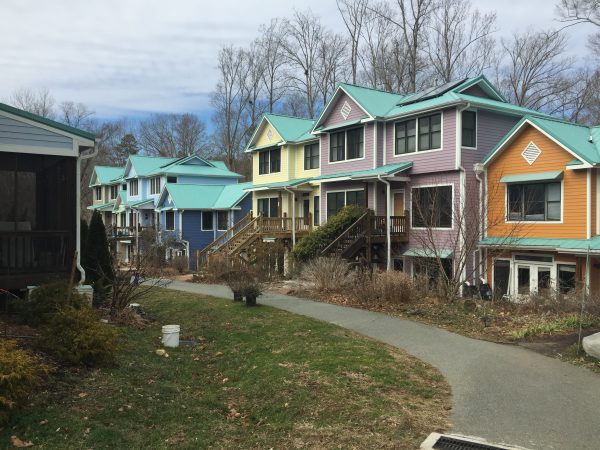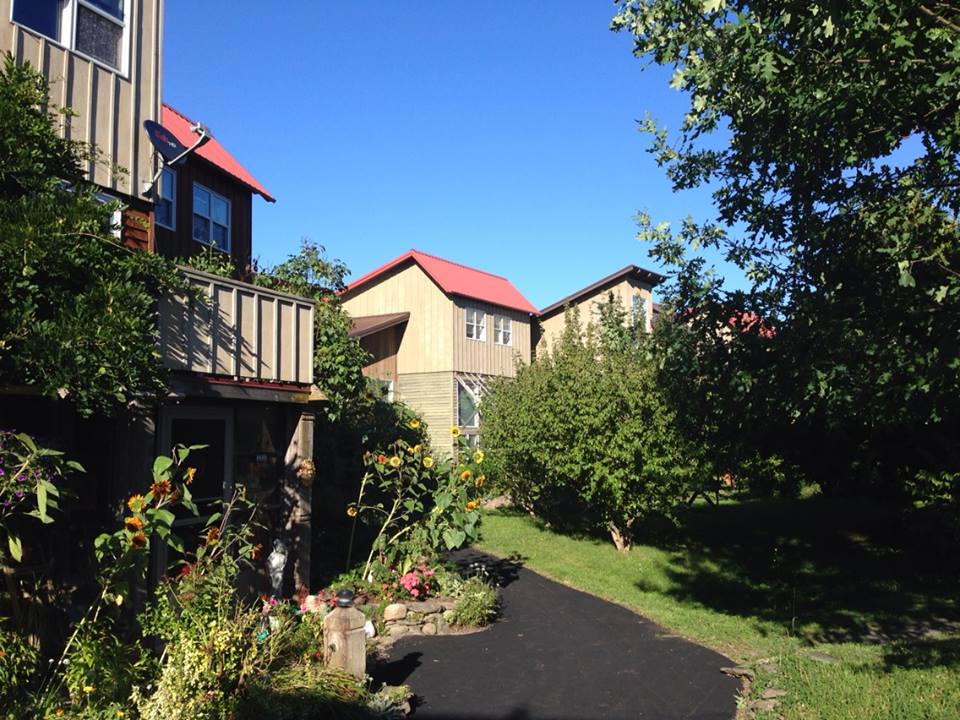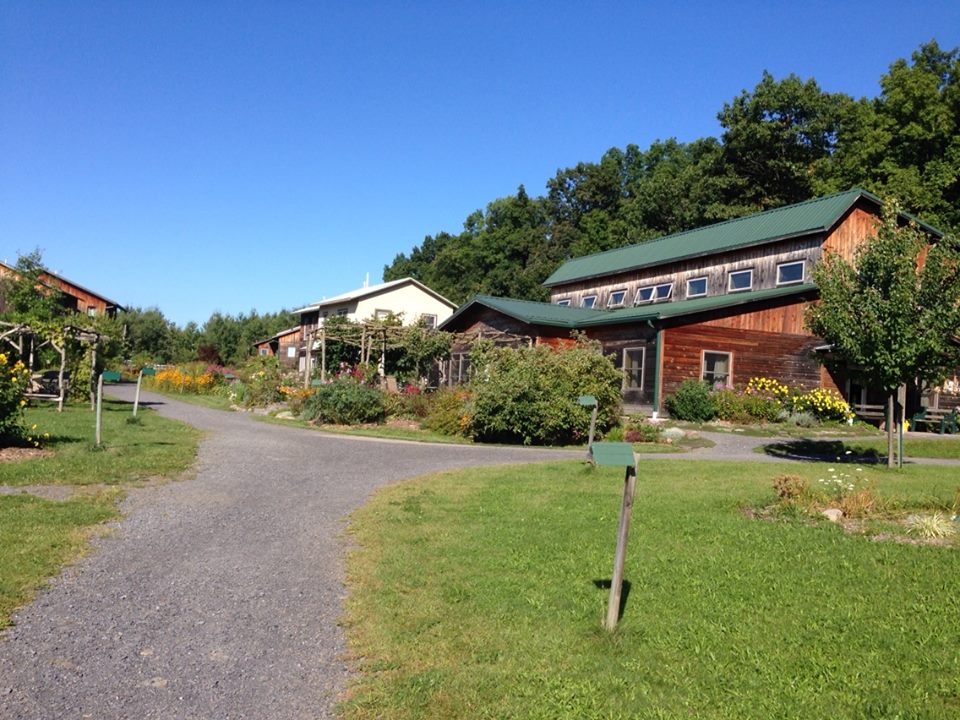Cohousing: Square peg development in a round-hole world

Cohousing is a concept that tries to fit an unusual form of housing into current-day development regulations—a square peg in a round hole is how Robert Boyer puts it. Boyer is an assistant professor in the UNC Charlotte Department of Geography & Earth Sciences where he teaches classes in urban and regional planning and sustainability. He researches experimentation in the built environment, and one of those innovations he studies is cohousing. PlanCharlotte interviewed Boyer about cohousing—what it is, why it’s being built, and the problems cohousing communities can face. Boyer’s comments, edited for length and clarity. Or you can listen to the May discussion on our “PlanCharlotte: Talk of the Towns” podcast.
Q. First, what in the world is co-housing?
A. I like to describe cohousing as a private dwelling units clustered around collectively owned and managed spaces and facilities. In a basic sense it is houses or apartments that share access to things that typical homes consume and access in isolation. A normal single-family home in America has a back yard and a front yard and a kitchen that they use to the exclusion of everyone else. Cohousing tends to cluster these things together, so you have a neighborhood with shared access to recreational space, a large commercial kitchen and things like a library, a children’s playroom and meeting spaces without necessarily excluding those from individual homes. An individual home may have a kitchen but it will be smaller, and you can use an enormous commercial kitchen with all the appliances you ever wanted and couldn’t afford as a single household.
Q. Why would people want to do this?
A. Right now there are lots of people considering co-housing. One demographic very excited about cohousing is retirees. The leaders of the cohousing movement have invested a lot of energy into offering cohousing as an option to Baby Boomers and empty nesters who want to downsize and don’t want to live alone. A couple of national surveys have examined who’s living in cohousing, and it is disproportionally women, disproportionally educated, disproportionally a little older, and disproportionally higher-income. That doesn’t mean there aren’t men or married couples, but it seems to be attracting people who want to live in a social atmosphere but might not have that in a typical housing situation.
Q. I wonder how much of that appeal to an older demographic is tapping into Baby Boomers’ memories of the ’60s and ’70s communes, which maybe they never lived in but thought sounded cool.
A. Cohousing and communes are distant cousins, united by a common ancestor. The United States has over 300 years of history of collectivist communities. Even Puritan communities in the early days of the United States were founded on mutual support. In Puritan settlements in the 1600s they shared access to common spaces and there was a lot of loyalty to the integrity of the neighborhood.
But in a lot of ways cohousing communities are different from the “hippie communes” of the’60s and ’70s. Cohousing communities today tend to be much better organized, and tend to last a bit longer than the hippie communes that came and went in a couple of decades. And most cohousing residents who work tend to have jobs in the mainstream, like anyone else.

In many ways, housing in the FROG neighborhood of EcoVillage at Ithaca looks like a typical subdivision. Photo: Robert Boyer
Q. Some of your research was on sustainability and how cohousing might be a tool to become a less carbon-emitting society.
A. There is some evidence that cohousing communities consume fewer resources than communities in the same place and of the same size, all other things equal. Housing is complicated, and there are lots of different variables that determine an ecological footprint. But smaller homes require less energy to heat and cool and fewer materials to build. When you have more people living in smaller homes and sharing more stuff, this requires fewer resources.
Many cohousing communities tend to unite around light-green values. Probably my favorite feature of cohousing is a marginalization of automobiles. Most cohousing communities have no driveways and no internal paved pathways or sidewalks. You park, get out of your car and walk from house to house. A lot of communities choose to share cars.
Q. How do they set the rules? You’ve got all these different people, and anybody who’s ever served on or observed a homeowners’ association knows there is all kinds of stuff between people. How do you figure all this out?
A. That stuff between people doesn’t disappear. People involved in cohousing are like anyone else—they get stressed, they get frustrated with one another. But something I find remarkable and encouraging across the movement is a deliberate effort to learn how to resolve interpersonal conflicts. Communities, when they’re founded and as they continue, invest in consensus governance skills. They sit down and learn how to make decisions together. Communities invest highly in this so they can work through the conflicts that are inevitable when you’re making rules about how to live together.
Q. You’ve done research on the problems cohousing communities encounter. What are some of the hurdles?
A. Communities that succeed and get built have put a square peg in a round hole. There are a lot of reasons cohousing doesn’t fit the mainstream model. One is that in America today and for the last hundred years or so, the processes of housing production and housing consumption are completely separate. Cohousing development completely flips that model. Rather than having buyers and sellers you have members. You have to recruit members, ask them to invest in something they’ve never seen and sometimes that they’ve never heard of. Recruiting people is a long process. Initiatives sometimes spend years hosting socials and potlucks week after week to help explain this idea to people.
There are other obstacles. The financial model for cohousing is challenging. Banks find it a little foreign and unproven, and so it can be hard to get loans for buying land and building the structures. Communities that succeed are usually partnering with local professionals who have connections to banks and can vouch for the success of the community.
Q. What about zoning?
A. Zoning is kind of a mixed bag. Some communities choose their land based on the zoning. You might find a place with the right multifamily zoning and build it there. Those communities may have little trouble with zoning. Usually the thorniest part of zoning is parking requirements, because standard zoning usually requires a certain number of parking spaces per dwelling unit. If you don’t really want to have as much parking, you have to negotiate that down.
Other issues come with subdivision regulations—for example, the sewage infrastructure you have to include and the types of sidewalks you have to include. If a community doesn’t want sidewalks, or thinks it can succeed by sharing some sewer infrastructure, those subdivision regulations defy that mission.
Bigger problems include communities that want to settle where there is no multifamily zoning. If you’re in a jurisdiction where neighbors don’t understand the idea of cohousing, you may get a lot of opposition to a zoning change.
Q. There’s a cohousing initiative in Charlotte.
A. There has been a cohousing initiative in Charlotte, or at least the seeds of an initiative, for about three years. The initiative has run into similar struggles that cohousing initiatives all over the United States run into have, in part because this is a region that has never done cohousing.
We’re really lucky because just up the road in the Research Triangle area there now six communities, and several being built, so there’s some experience there. But in Charlotte it’s a pretty new concept, so the initiative here has had trouble recruiting individuals, keeping individuals and raising the money to invest.
I am in touch with some members of that group. My understanding is that they are beginning to engage a developer, and I think that will help them gain traction. I am really excited to see what will happen with it. If you’re interested, they have a website and a Facebook page, where you can check out their meet-up group.
Q. When I told a couple of my colleagues what cohousing is, they were enthusiastic about the concept. What do you think the market is for this?
A. Because there are so many reasons it is hard to develop, it is still very much a niche market. There’s just so much work on the front end.
What I’m seeing and I think is an optimistic sign is a few developers outside the cohousing movement that have begun creating cohousing without calling it that. Some of them say they “recreate the college experience” for young professionals. Some are piggybacking on this trend called the sharing economy or collaborative consumption, where you can access objects and services without having exclusive ownership.

The common house in the SONG neighborhood at EcoVillage at Ithaca. Photo: Robert Boyer
Q. You’ve studied cohousing developments across the country. Do any stand out as particularly good examples?
A. My favorite is EcoVillage at Ithaca (N.Y.), only because I’ve studied it, and it was one of the earliest and has managed to influence changes in the jurisdiction there. It’s a fascinating community. Last I checked there are 175 residences in a little over 100 units. They have divided their community into three neighborhoods. It’s also one where research confirmed their ecological footprint is 40 percent of the average American’s, which is very encouraging to hear.
In the region between Denver and Boulder in Colorado there is a lot of cohousing, because a couple of innovative developers have partnered with grass roots initiatives.
Unsurprisingly the San Francisco Bay Area is the origin for cohousing in the United States, though I should add that it was imported. The first cohousing communities were in Denmark. The idea was imported by a couple that came back to the United States and has written the book on cohousing. [Cohousing: A Contemporary Approach to Housing Ourselves (1994) by Kathryn McCamant and Charles Durrett]
Q. If people are interested in learning more, how can they reach you?
A.
Reach me by email at RBoyer1@charlotte.edu.